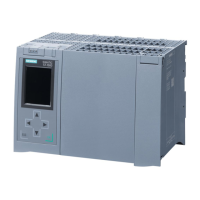S7-1500R/H redundant system
System Manual, 01/2024, A5E41814787-AF
317
Basics of program execution
10.1 Programming the S7-1500R/H
User program for the S7-1500R/H redundant system
For the design and programming of the user program, the same rules apply for the redundant
S7-1500R/H system as for the S7-1500 automation system.
The user program is stored identically in both CPUs in redundant operation. Both CPUs
process the user program event-synchronously.
From the point of view of user program execution, the S7-1500R/H redundant system
behaves like the S7-1500 automation system. Synchronization is integrated into the
operating system and runs automatically and hidden between the primary and backup CPU.
Specific instructions and blocks for the S7-1500R/H redundant system
Specific instructions and OBs are available for the S7-1500R/H redundant system.
"RH_CTRL" instruction
With the "RH_CTRL" instruction, you can influence the redundant system as follows:
• Lock performance of SYNCUP (Mode 3) or release performance of SYNCUP again (Mode
4).
The goal is to allow SYNCUP only in less critical process phases if necessary (see
Disabling/enabling SYNCUP with the RH_CTRL instruction (Page 329) section for more
information).
As of firmware version V2.9:
• Request SYNCUP (Mode 7).
With this function, you can request a SYNCUP via the user program in RUN-Solo system
state.
• Switch primary CPU to STOP mode (Mode 8, only in RUN-Redundant system state).
In an emergency (e.g. fire alarm in the area of the primary CPU), you can perform a
primary-backup switchover as a precaution with this function.
• Switch backup CPU to STOP mode (Mode 9).
As of firmware version V3.0:
• Query current status, whether SYNCUP is blocked or enabled (mode 10).

